5.4 The bond pricing model
5.4 The bond pricing model
Langetieg presents a general model for pricing default-free bonds . The model allows any number of underlying stochastic factors which follow an arbitrary Ito process. Although the form of the solution can always be obtained, an explicit solution can only be determined for certain distributions. The case considered here, where the underlying factors follow a multivariate elastic random walk, is mathematically tractable and hence an explicit solution can be found.
5.4.1 The Equilibrium bond price equation.
Let P = P ( t, T, x )be the time t price of a default-free discount bond paying $1 at time T . Applying Ito's Lemma, the bond price generating process is:

where
that is, ¼ P is the expected rate of return and ² i P the unanticipated rate of return due to unexpected changes in factor x i . A no arbitrage argument may be applied to derive the partial differential equation for the bond price. Let P be a portfolio of n + 1 bonds P j , with maturities T j and portfolio weights ³ j , such that & pound ; n +1 j =1 ³ j =1. Then

where
Hence, by Ito's Lemma the stochastic process for the bond portfolio is:
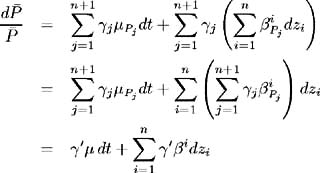
where
For the portfolio to be risk-free, its return must be deterministic and hence the coefficients of the stochastic terms must be zero. That is:
To prevent profitable arbitrage, the return on the bond portfolio must be the risk-free rate of interest and hence:

The vector ³ is an ( n +1) vector and by (5.11) it is orthogonal to the n vectors ² i . Additionally, (5.12) implies that ³ is orthogonal to vector ( ¼ ˆ’ r ). An ( n +1) vector can be orthogonal to at most n independent vectors in an ( n +1) space; hence ( ¼ ˆ’ r ) must be a linear combination of the ² i s, i =1, , n ,and so:
where » i , i =1, , n are scalars which may depend on time and the underlying stochastic factors. (5.13) is a matrix equation with ( n + 1) elements, one for each of the bonds in portfolio P . Since » i , i = 1, , n are independent of the bond maturity, that is they are the same for every bond P j in portfolio P , (5.13) applies to any bond P :
This equation is the equilibrium condition for the instantaneous expected rate of return on a bond where each » i , i =1, , n may be interpreted as the market risk premium associated with factor x i . Substituting for ¼ P and ² i P from (5.9) and (5.10), we derive the equilibrium bond price equation:

with boundary condition P ( T,T )=1.
5.4.2 Risk-neutral measure.
The solution of (5.15) takes the form:

where

This valuation is obtained by transforming to a risk-neutral measure via the Girsanov Theorem [6] and applying the Feynman-Kac Theorem (see [ 45 ]). Consider (5.14), that is:
Substituting into (5.8), the bond price generating process, we have:
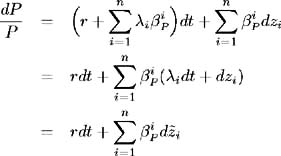
where, by the Girsanov Theorem, d ![]() = » i dt + dz i , i =1, , n are Brownian motions under the equivalent martingale measure. This change of measure technique has taken us into the risk-neutral world where the bond price grows at the deterministic risk-free rate of interest r ( t ), and some stochastic component driven by the transformed Brownian motions,
= » i dt + dz i , i =1, , n are Brownian motions under the equivalent martingale measure. This change of measure technique has taken us into the risk-neutral world where the bond price grows at the deterministic risk-free rate of interest r ( t ), and some stochastic component driven by the transformed Brownian motions, ![]() i =1, , n . Now we solve for the market risk premium vector.
i =1, , n . Now we solve for the market risk premium vector.
Suppressing the notational dependence on P , we have:

In vector notation, (5.14) becomes:

and so
This expression for the market risk premium vector takes into account the correlations between various Brownian motions. It can be shown [7] that
where »ƒ ² and ˆ’ 1 are defined in (5.16). Also [8]
Hence the bond pricing formula (5.16) follows by Girsanov's Theorem.
5.4.3 Bond price solution.
A solution to (5.16) can only be found if the probability density function of A ( T ) is known and hence the expectation can be evaluated. Alternatively, numerical procedures may be applied directly to partial differential equation (5.15) to obtain the bond price solution.
Consider the solution to (5.16) under the assumption of a multivariate elastic random walk. Since the instantaneous short- term interest rate may be expressed as a linear function of the underlying stochastic factors, we have from (5.2) and (5.3):

Hence (5.16) becomes:

Since A ( T ) is normally distributed [9] , we may evaluate the bond price as [10] :
where [11]
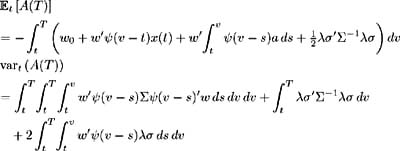
An explicit bond price is obtained by evaluating the above integrals.
5.4.4 Alternative approach to determining the bond price.
Alternatively, considering equation (5.8)
we see that bond risk, that is the unexpected changes in bond price, is related to the bond gradient vector where the gradient is taken with respect to the underlying stochastic factors. From (5.19), the bond gradient vector is:

Let ” ( t, T ) denote the normalised gradient vector, that is:

This defines the bond risk per unit bond and hence ” ( t, T ) represents the bond risk vector. Next, calculate the expected instantaneous equilibrium return on the bond. From (5.13), derived by means of a no arbitrage argument and (5.10), the definition of ² i , the expected instantaneous equilibrium return of the bond is:

where ![]() as defined in (5.20). Hence the bond price generating process (5.8) becomes:
as defined in (5.20). Hence the bond price generating process (5.8) becomes:

By Ito's Lemma we have:



where P ( s, T ) is a known value of the bond at some time s ‰ t . From (5.6):
which implies

by (5.17), and so
Therefore (5.21) becomes

where L ( v, t ) = ˆ ( v, T ) ² ƒ» ˆ’ ½ ˆ ( v,T ) ² ˆ ( v,T ).
Now making use of (5.20), we have:
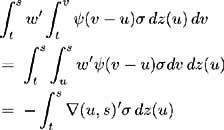
and
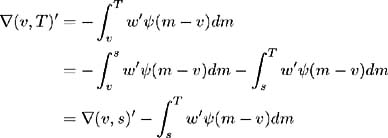
Hence (5.22) simplifies to

Now since ˆ ( m ˆ’ v ) = exp B ( m ˆ’ v ) for constant B , we have ˆ ( m ˆ’ v )= exp ( B ( m ˆ’ s )+ B ( s ˆ’ v )) and
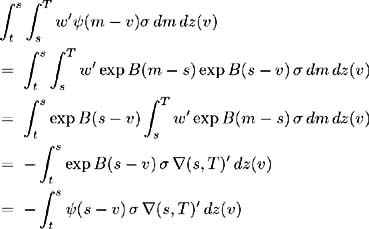
Also, from (5.5) and (5.6) we have:

Hence (5.23) becomes:
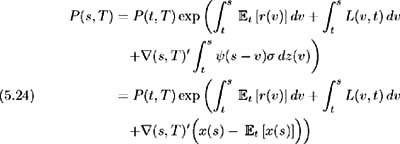
By the definition of P ( t, T ), we have the boundary condition P ( T,T ) = 1. Setting s = T in (5.24) above and noting that ˆ ( T, T ) = 0, solve for P ( t, T ) as:

This equation provides a simple and intuitive representation of the bond price. Changes in bond price may be attributed to the expected changes in the risk-free rate of interest and another term dependent on the underlying economic factors.
By definition P ( t, T ) = exp( ˆ’ R ( t, T )( T ˆ’ t )), and so the term structure equation may then be determined as:

[6] The Girsanov Theorem, [ 43 , Theorem 8.6.4], states: Let Y ( t ) be an Ito process:
where B ( t ) is a Brownian Motion. Assume there exist functions ¼ ( t ) and ± ( t ) such that
where ¼ ( t ) satisfies
Set
and
then
is a Brownian Motion under ![]() and the Ito process for Y ( t ) may be represented in terms of
and the Ito process for Y ( t ) may be represented in terms of ![]() ( t ) as
( t ) as
[7] Here the result is shown in two dimensions, the extension to higher dimensions, follows naturally. Since ² ² =[ ² 1 ² 2 ], the covariance matrix is:
where ² 1,2 = ² 1 ² 2 . The inverse of this covariance matrix is:
From (5.10) we have ² i = ![]() ƒ i =
ƒ i = ![]() P i ƒ i and since ƒ 1,2 = ƒ 1 ƒ 2 :
P i ƒ i and since ƒ 1,2 = ƒ 1 ƒ 2 :

[8] Since and so ˆ’ 1 are symmetric matrices we know ( ˆ’ 1 ) ² = ˆ’ 1 .
[9] A ( T ) is normally distributed since it depends on a linear combination of stochastic factors generated by an elastic random walk, and the market prices of risk » i , i =1, , n , are deterministic.
[10] Consider a random variable X , which is normally distributed, X ~ ( ± , ² ). The probability density function of X is:
and hence the expected value of any function of X , u ( x ) is calculated as:
Let u ( x )= e x , and noting that e x = 1 + x + ![]() +
+ ![]() + , we have
+ , we have

Since ![]() [ X ]= ± :
[ X ]= ± :
and

for some ˆˆ ![]() . Hence
. Hence

[11] To calculate var t ( A ( T )), the variance of A ( T ), consider:

Since var t ( A ( T )) = covar t ( A ( T ) v , A ( T ) v ) we have:

EAN: 2147483647
Pages: 132
- Using SQL Data Definition Language (DDL) to Create Data Tables and Other Database Objects
- Understanding SQL Transactions and Transaction Logs
- Working with Functions, Parameters, and Data Types
- Working with SQL JOIN Statements and Other Multiple-table Queries
- Working with Ms-sql Server Information Schema View